 |
||||||
| Another room with large-scale sound was the combination of Reimyo/Harmonix CDP, the humongous CAT monos and the German Ascendo speakers now distributed by Darren Censullo of Avatar Acoustics [below left, with designer Jürgen Scheuring to his right). Darren worked with Nizar Akhrass of May Audio until deciding to go solo. Landing this brand for his first feather in the cap seems like quite the coup. Long since a favorite with Yamada-San of Zanden Audio (whose own room used a smaller Ascendo speaker model), this German speaker line benefits from ribbon tweeters, proprietary bass loading and adjustable time alignment. In combination, these ingredients clearly operate at a very high level. Our own Jules Coleman might be doing the honors on a review if his and Darren's schedules can be sync'd up. Jules' people will call Darren's people... |
||||||
 |
||||||
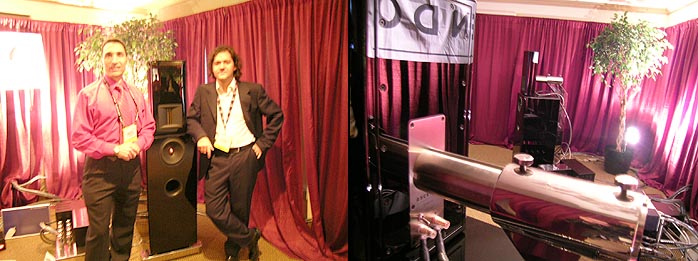 |
||||||
While still completing my Top Ten lineup, importer Brian Ackerman's twin-system display with Acapella and Einstein was in many ways the most spectacular sound at CES. The wicked ion tweeter of the Violin MkIII [far lower right] must be the finest HF transducer ever to grace a commercial consumer loudspeaker [close-up of tweeter below right, with Volker Bohlmeyer of Einstein and Brian Ackerman adjacent, holding the Einstein system remote and shipping crate respectively]. |
||||||
 |
||||||
Spectacular doesn't always lead to long-term musical satisfaction. Still, considering show conditions and the fact that these speakers had very little time on them, I venture an educated guess that certain minor reservations during my audition would probably no longer hold water at home. While the smaller Acapalla speaker suffered a strange lack of center lock, its four paralleled small bass drivers actually produced superior bass to the bigger brother. If the German designers [Hermann Winters below next to the La Campanella's 700Hz+ asymmetrical horn] could combine the midrange horn and tweeter of the Violin with the bass array of the smaller La Campanella, they'd have a truly scary dream speaker. I was surprised by the relative modest dimensions of both speakers. They were a lot smaller and far more living-room friendly than anticipated from adverts and photographs. I'll be reviewing a pair of La Campanellas in the second quarter. |
||||||
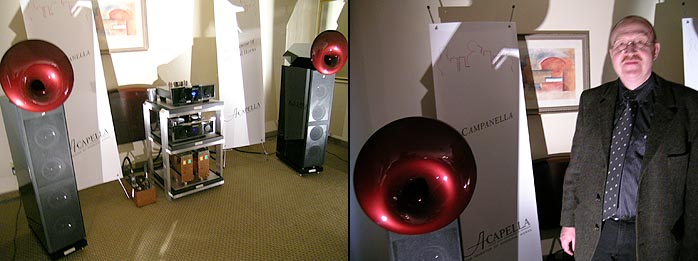 |
||||||
Certain reviewers previously unfamiliar with the Einstein lineup were shocked to discover that their tube monoblocks driving the Violins were OTLs. Nothing in the drum solo tracks indicated a lack of rise times, control or speed. Truly, these are very special amplifiers. Whoever reviews them is guaranteed a smokin' good time of unexpected discoveries. |
||||||
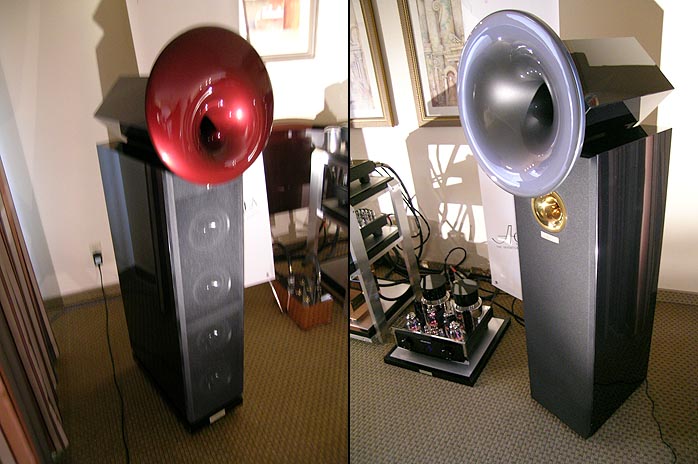 |
||||||
One last room that mandates mention for a highly dynamic, properly scaled, accurate and clean presentation was the Peak Consult/ Stereovox/Wavac exhibit with the massive Continuum Audio Labs turntable from Australia. |
||||||
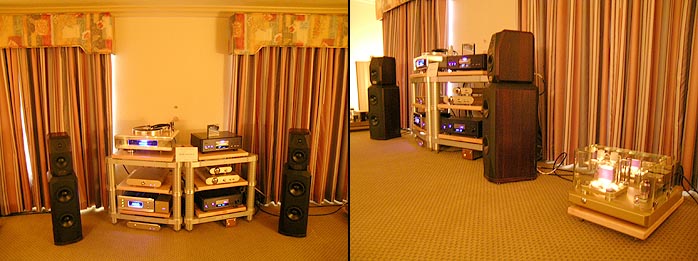 |
||||||
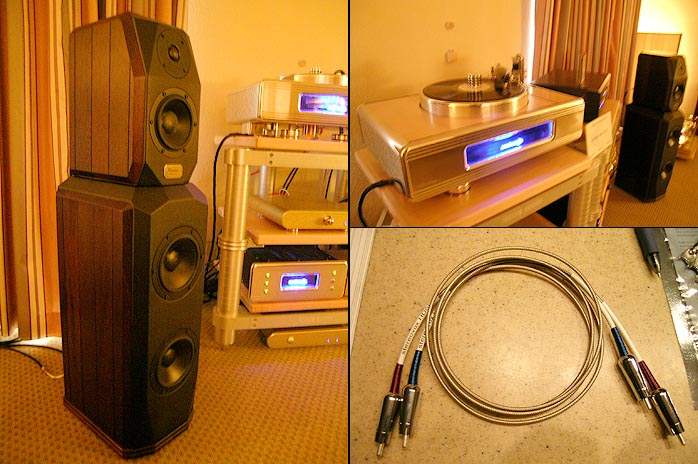 |
||||||
US importer Chris Sommovigo of Stereovox offered to disconnect the optional woofer tower to run the Princess monitors ($10,000/pr standard finish) solo. To say that these are not your grandfather's wimpy-chested two-ways is a colossal understatement - most certainly when powered by the humongous Wavac monos. In ne-plus-ultra monitor land, there are a couple of fierce contenders. Alon Wolf's Magico Mini [below] resides possibly at the very top of this esoteric heap. An upcoming visit to his California factory will explore this subject in more depth to -- possibly -- result in an exclusive review assignment. The chap leaning on the speaker below is Vince Sanders of VRS Audio Systems who, like Jeff Rowland, employed it in his system. The Peak Consult Princess and TAD two-way used by Bel Canto Design can't be much behind the Magico. Then there's the StarSound Technologies' Caravelle at $5,000/pr plus stands as my most affordable personal entry into these exclusive go-for-broke leagues. It's a speaker due for review that I'm really excited over. At the St. Tropez, it put in a far stronger showing than the more-than-twice as expensive Ultimate Monitor which David Robinson of Positive Feedback reviewed recently. To turn the Princess monitor into a four-driver three-way will set you back $20,000/pr in standard dress code. The Wenge wood shown above (Chris Sommovigo's treasured personal pair) demands a $2,000 surcharge in both monitor and 3-way iterations. |
||||||
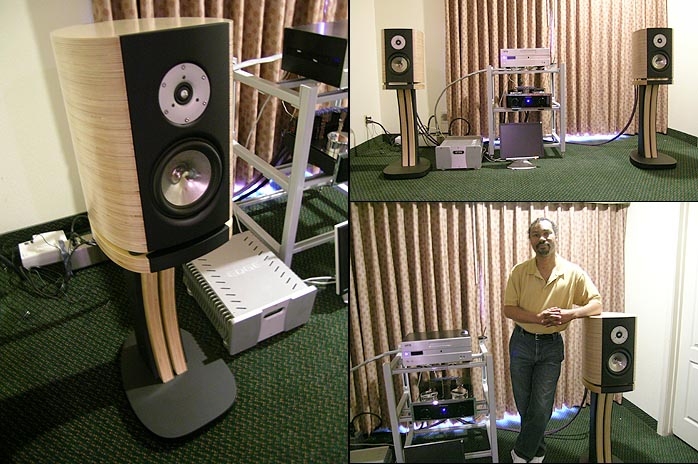 |
||||||
 |
||||||
Like the bass section of the Overkill Audio Encore -- and the internals of the TAD monitor [left with Bel Canto], the head unit of the Vandersteen 5 and the entire enclosure of the Gershman Acoustics Opera Sauvage -- the Magico Mini is assembled of stacked sheets of Birch ply which can be contoured into organic shapes while allowing for joint-less internal bracing or even wave-like surfaces. On the subject of Bel Canto, expect a ca. $4,500 PLayer 2 and a HighEnd RedBook-only CD player to flesh out the current lineup. The firm's John Stronczer is also working on a statement-level high-power monoblock to demonstrate to the remaining heathens that "digital" amplifiers can run with the big Krells and Classés and not break a sweat when it comes to punishing low-impedance loads. And before I forget it, Stereovox debuted their HDSE interconnect based on a thin-wall hollow copper tube for its main conductor that's terminated with proprietary RCAs. Like Crystal Cable, this wire is thin and flexible. This particular model is $200/pr. I've got one for review [scroll back up to the Peak-Consult images to see the HDSE in all its glory). Crystal Cable hasn't rested on its laurels either despite signing on more than 20 distributors in its first year of operations. Gabi Van Der Kley introduced a new Micro line of which the new Piccolo interconnect looks extremely promising. It employs the same Kapton cross-wrapped dielectric and Furutech plugs but shrinks the silver/gold conductor to an even slimmer diameter than the Reference line. While high-level signal requires a certain mass to carry current, low-level signal (at least in my experience) seems to do best with ultra-thin conductors. Despite having sworn off cable reviews since the appearance of the Stealth Indra and Crystal Reference in my system, I did pick up a pair of Piccolos. I'm just not sure what to say should I prefer the skinnier and cheaper Piccolo to the thicker (though still very thin) and costlier Crystal Reference. I guess I cross that bridge when the time comes? Or should I remember that I opted out of cable reviews altogether and keep my big mouth shut? Hmm... |
||||||
 |
||||||
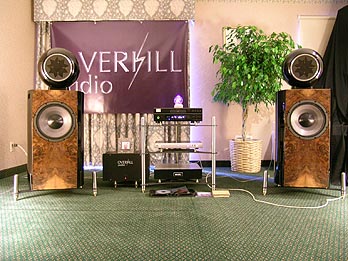 |
||||||
 |
||||||
| Before we leave this page, we have to return to the Aussie Caliburn deck by designer Mark Doehmann and chairman David Payes. These blokes clearly have their own ideas about reference caliber turntable design and the sleek integrated look of their table in Per Kristoffersen's Peak Consult exhibit cleverly hides a few unique design parameters. There's the ceramic alloy used for the chassis; cast alloy/ceramic bearings for "vacuum pressure"; something described as "true zero cogging, battery-powered linear controlled DC brushless servo motor control with patented coil technology for 0.006% real-time speed error stability". Then there's the integral Cobra tonearm that | ||||||
 |
||||||
| seems a substantial departure from the norm in both shape and choice of materials. A true vinyl chap like Michael Fremer or our own Jules Coleman will have to take the measure here but even an unwashed vinyl heathen such as yours truly has to suspect that this Continuum Audio Labs design bears keeping close tabs on. | ||||||
 |
 |
|||||
 |
||||||